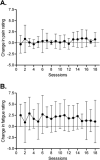Translating animal doses of task-specific training to people with chronic stroke in 1-hour therapy sessions: a proof-of-concept study
- PMID: 20424192
- PMCID: PMC3235711
- DOI: 10.1177/1545968310361957
Translating animal doses of task-specific training to people with chronic stroke in 1-hour therapy sessions: a proof-of-concept study
Abstract
Objective: The purposes of this study were to (1) examine the feasibility of translating high-repetition doses of upper-extremity (UE) task-specific training to people with stroke within the confines of the current outpatient delivery system of 1-hour therapy sessions and (2) to gather preliminary data regarding the potential benefit of this intensity of training.
Methods: A total of 15 patients with chronic (>6 months) UE paresis caused by stroke underwent 3 weeks of baseline assessments followed by 6 weeks of the high-repetition intervention (3 sessions/wk for 6 weeks). During each 1-hour session, participants were challenged to complete 300 or more repetitions of UE functional task training (3 tasks x 100 repetitions). Assessments during and after the intervention were used to measure feasibility and potential benefit.
Results: For the 13 participants completing the intervention, the average number of repetitions per session was 322. The percentage of sessions attended was 97%. Participant ratings of pain and fatigue were low. Action Research Arm test scores improved an average of 8 points during the intervention and were maintained at the 1-month follow-up. Secondary measures of activity and participation increased, but the measure of impairment did not.
Conclusions: It is feasible to deliver hundreds of repetitions of task-specific training to people with stroke in 1-hour therapy sessions. Preliminary outcome data suggest that this intervention may be beneficial for some people with stroke.
Figures




References
-
- Teasell R, Foley N, Salter K, Boghal S, Jutai J, Speechley M. Evidence-based review of stroke rehabilitation. University of Western Ontario; London, Ontario: 2008.
-
- Karni A, Meyer G, Jezzard P, Adams MM, Turner R, Ungerleider LG. Functional mri evidence for adult motor cortex plasticity during motor skill learning. Nature. 1995;377:155–158. - PubMed
-
- Nudo RJ, Plautz EJ, Frost SB. Role of adaptive plasticity in recovery of function after damage to motor cortex. Muscle Nerve. 2001;24:1000–1019. - PubMed
Publication types
MeSH terms
Grants and funding
LinkOut - more resources
Full Text Sources
Medical

